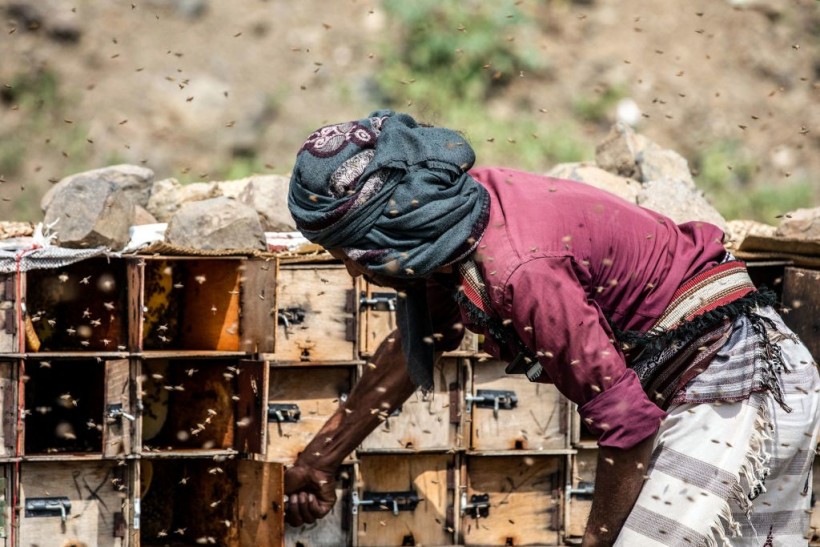According to a study published in Environmental Microbiome, urban honey bees could be used to gain insight into the microbiome of the cities in which they forage, which could potentially provide information on both hive and human health.
Honey bees provide a snapshot of city landscape and health
 (Photo : AHMAD AL-BASHA/AFP via Getty Images)
(Photo : AHMAD AL-BASHA/AFP via Getty Images)

Cities are designed for human habitation, but they also house a diverse range of living species, and understanding this diverse landscape is critical for both urban planning and human health.
However, sampling the microbial landscape in order to cover large areas of a city can be time-consuming, as per Phys.org.
Elizabeth Hénaff and colleagues investigated the potential of honey bees (Apis mellifera) to assist in the collection of microorganism samples across cities, as honey bees have been observed foraging up to one mile from their hives in urban environments on a daily basis.
In a pilot study, they sampled various materials from three hives in New York and discovered diverse genetic information, including from environmental bacteria, in the debris accumulated at the bottom of the hives.
Subsequent hive debris samples from Sydney and Melbourne (Australia), Venice (Italy), and Tokyo (Japan) indicated that each location has a distinct genetic signature as seen by honey bees.
Fungi associated with wood rot and date palm DNA dominated the genetic data in Venice.
The sample from Melbourne was dominated by eucalyptus DNA, whereas the sample from Sydney contained little plant DNA but genetic data from a bacteria species that degrades rubber (Gordonia polyisoprenivorans).
Plant DNA from Lotus and the wild soybean, as well as the soy sauce fermenting yeast Zygosaccharomyces rouxii, were included in the Tokyo samples.
Furthermore, the authors gathered genetic material from hive debris for Rickettsia felis ("cat scratch fever"), a pathogen spread to humans through cat scratches.
These findings suggested that this has potential as a surveillance method, but they are currently too preliminary to tell that it is an effective method of monitoring human diseases.
Bee-related microorganisms were also found in the hive debris, most likely from honey bee parts.
The authors discovered known bee microorganisms, whose presence indicates a healthy hive, in 33 samples from hives across the following four cities, and bee pathogens, such as Paenibacillus larvae, Melissococcus plutonius, or the parasite Varroa destructor, in some hives.
According to the authors, these findings suggested that debris could also be used to assess the overall health of the hives.
Also Read: Bees Activate 'Medicinal Properties' Against Parasite Infection During Pollination
Urban Beekeeping
The practice of working with bees in cities is known as urban beekeeping.
Honeybees, as well as solitary bees like masons, leaf cutters, and diggers, and some social bees like carpenters and bumbles, can fall into this category, as per The Best Bees.
Most people work with honeybees because of the practice's long history, which dates back over 9,000 years.
Urban beekeeping with honeybees, like rural and suburban beekeeping, entails founding colonies with queens and worker bees, housing them, providing supplemental feeding when necessary, assisting them in pest control, and harvesting honey when surpluses exist.
Many people still find it strange to keep bees in cities, possibly because we think of suburbs and rural areas as more natural environments, and cities as largely man-made spaces devoid of nature.
Honeybees are not native to the Americas; they were introduced into English colonies in the 1670s.
For generations, North American beekeeping was an essential part of family farming, and the American food system was still largely based on small farms until the mid-twentieth century.
After WWII, when supermarkets, fast food, and agribusiness took over most of our food system, people lost touch with the sources of their food, including honey and beekeeping.
The call for city bees was first heard in 1980s Paris, when experimental hives on the roof of the famed Opera Garnier proved so successful that they launched a new industry in France: Urban Beekeeping.
Today, the greater Paris area alone has over 3,000 hives, and urban beekeeping has spread around the world.
The movement in the United States was initially hampered by municipal legislation restricting the raising of farm animals in cities, including bees.
However, beekeeping activists persisted, and cities in the United States began to change their laws.
In 2010, New York legalized urban beekeeping; in 2013, Boston; and in 2015, Los Angeles.
Related article: Taal Wipes Out Bee Farm in Laguna
© 2024 NatureWorldNews.com All rights reserved. Do not reproduce without permission.





